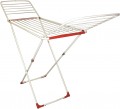Total working surface
Under the total working surface is meant the total length of all drying rods in the expanded state. The
longer this length, the more laundry can be placed on the dryer and, usually, its maximum load is higher (see below). At the same time, this parameter also affects the dimensions and price of the device.
Max. load
The highest weight of laundry that can be dried (of course, we are talking about wet laundry). In addition to the general weight limit, the detailed specifications can also specify the allowable load on each individual rod.
At home, it is impossible to accurately control compliance with this limitation, but it is still worth taking measures to prevent overload. After all, although many drying racks have a certain margin of safety and can carry a lot of weight without visible consequences, off-design loads on the structure reduce its durability and increase the risk of unexpected breakdown.
Number of rods
The number of individual rods provided for in the design of the drying rack. The more such rods are provided for with the same total working surface, the shorter the length of each of them and the more compact the dimensions of the device in the unfolded state can be. On the other hand, short rods are poorly suited for sheets, blankets and other large items.
Side wings
The side wings are additional folding shelves, provided mainly in floor models (see "Type") and installed at the ends. Such shelves allow, if necessary, to increase the usable area, and when not in use, they usually fit directly on the main work surface and do not take up extra space in the surrounding space.
Transport rollers
The presence of
rollers or other similar devices that allow you to roll the structure along the floor. Drying racks usually do not weigh so much as to create problems when carrying, even quite large ones; but with laundry hanging out, moving from place to place without rollers can be quite a challenge. In addition, transport rollers are often found in models with 3 — 4 tiers, which are inconvenient to carry, not so much because of their weight, but because of their bulkiness.
Dimensions (unfolded)
General dimensions of the drying rack in working position, taking into account all additional elements — side wings (see above), retractable parts (see "Design"), etc. This parameter will allow you to estimate how much space is required to use a particular model.
Dimensions (folded)
General dimensions of drying rack in the folded position. The smaller they are, the more convenient this model is in storage and transportation.

